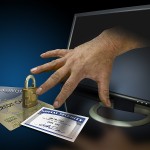How Do I Protect Myself From Fraud and Identity Theft?
How Do I Protect Myself From Fraud and Identity Theft?
Living in these times of digital growth, fear is a constant companion. It is really scary to hear the stories of people who have had their lives destroyed because someone stole their identity.
What is identity theft, anyway? How does it happen? Credit fraud is a broad term for the use of a credit card or any comparable type of credit, to buy goods or services with the intention of evading payment. Identity theft is the fastest growing crime in America. The number of identity theft incidents has reached 9.9 million per year, according to the Federal Trade Commission. Every minute, about 19 people fall victim to identity theft.
It takes the average victim an estimated $500 and 30 hours to resolve each identity theft crime,  according to TransUnion®, one of the three largest credit reporting bureaus. According to TU, one study found 32% of identity theft victims discovered a family member or relative was responsible for stealing their identity. That same study found 18% were victimized by a friend, neighbor or in-home employee. Only 29% of identity theft cases involve credit or financial fraud. Phone, utility, bank and employment fraud make up another 50% of cases.
according to TransUnion®, one of the three largest credit reporting bureaus. According to TU, one study found 32% of identity theft victims discovered a family member or relative was responsible for stealing their identity. That same study found 18% were victimized by a friend, neighbor or in-home employee. Only 29% of identity theft cases involve credit or financial fraud. Phone, utility, bank and employment fraud make up another 50% of cases.
Fraud and identity theft against children is one of the fastest growing segments of this phenomenon, and you wonder how that could happen? In today’s society, when a child is born, a social security number is assigned to that child. But the child will not actually use that number for at least 15 years. Usually what happens is a family member or care worker uses that number to obtain credit or employment, and you are none the wiser. Then later when the child gets old enough and applies for credit, you will find that there is already a credit history for that social security number. If the thief is unfortunate enough to be accused of a crime, those crimes could become associated with your child’s record.
Types of credit fraud include:
Identity Theft – the unauthorized use of personal identification information to commit credit fraud or other crimes.
Identity Assumption – the long term victimization of identification information
Fraud Spree – unauthorized charges on existing accounts
The ways that thieves can steal your identity and commit credit fraud include:
- Using lost or stolen credit cards
- Online identity theft
- Stealing from your mailbox
- Looking over your shoulder during transactions
- Going through your trash
- Sending unsolicited email
- Make false telephone solicitations
- Looking at personnel records
- Driver’s License number fraud
- Social security number used to commit identity theft
- Passport used in identity theft
- Mail fraud
- Check Fraud
 The warning signs that fraud may be occurring can include:
The warning signs that fraud may be occurring can include:
ü Inquiries on your credit report that you didn’t request
ü Strange charges show up on billing statements
ü Bills arrive from unknown or unfamiliar sources
ü You receive calls from creditors or collection agencies
ü Your child begins to receive suspicious email, like pre-approved credit cards
ü Opening a financial account for your child, finding one already exists
ü A credit report already exists in your child’s name
So what is a person to do? What steps can be taken to protect ourselves in our day to day world?
1) using a cross-cut paper shredder for anything that has numbers and/or names on it is key
2) only carry essential documents with you when you leave the house for any reason. Do not carry extra credit cards, social security card, birth certificate, or passport with you just to go to the store. Make sure your wallet only has essentials in it…driver’s license, and one credit or debit card, and some cash. Leave all other things behind at home.
3) pick up new checks at the bank rather than having them sent by mail.
4) request that your employer, landlord, or anyone else with access to your personal data keeps your records safe.
5) request credit and debit cards with your photo on the front, instead of signing the back. Write in “photo ID required” instead of putting your signature there.
5) make sure that you monitor your credit regularly for signs of theft or fraud. Take action immediately if you notice anything suspicious.
6) follow your credit card billing cycles closely. Note if an address changes, or a date changes without your request or knowledge.
7) keep a list of account numbers, expiration dates, and telephone numbers filed away. If your wallet is stolen, being able to quickly alert your creditors is essential.
8) online, create passwords or PIN numbers with a random mix of letters and numbers. It may be harder to remember, but you can use a service to help you keep track of them, such as www.Roboform.com.
Also See: What Do the Credit Reporting Agencies Do to Protect My Identity?
See Categories: Credit Education – Credit Restoration Credit Education – Credit Scoring Credit Education – Your Money Credit Education – Miscellaneous
